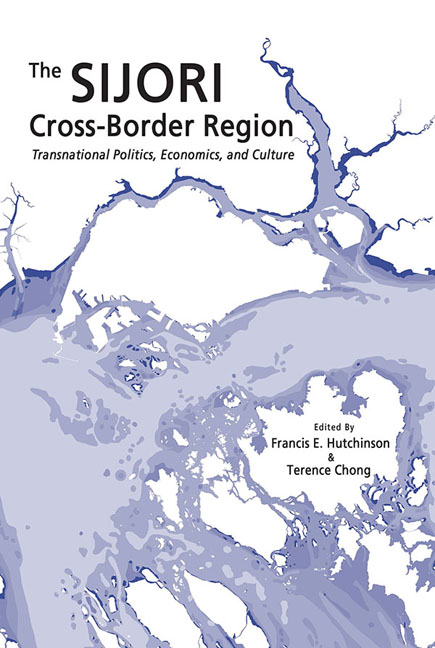Book contents
- Frontmatter
- Contents
- List of Maps
- List of Tables
- List of Figures
- Foreword
- Acknowledgements
- Contributors
- Abbreviations
- Introduction
- Section I Understanding the Whole
- Section II Policy and Politics
- Section III Cross-Border Social and Cultural Communities
- Section IV Formal and Informal Economies
- Conclusion
- Appendix
- Sources for the SIJORI Maps
- Index
Sources for the SIJORI Maps
Published online by Cambridge University Press: 22 July 2017
- Frontmatter
- Contents
- List of Maps
- List of Tables
- List of Figures
- Foreword
- Acknowledgements
- Contributors
- Abbreviations
- Introduction
- Section I Understanding the Whole
- Section II Policy and Politics
- Section III Cross-Border Social and Cultural Communities
- Section IV Formal and Informal Economies
- Conclusion
- Appendix
- Sources for the SIJORI Maps
- Index
Summary
The maps presented in this volume are based on the (digital) map data collection “Architecture of Territory: Singapore Metropolitan Region” which was assembled by ETH Zürich Assistant Professorship of Architecture and Territorial Planning, Milica Topalovic with Hans Hortig and Karoline Kostka at the Future Cities Laboratory in Singapore during 2011–15.
This map collection was created in order to visualize and thus help imagine, discuss and research the urban characteristics and urbanization process of the trinational metropolitan region centred in Singapore. It is the result of an extensive collection of map information originating from different sources, including existing planning documents provided by local authorities in three countries, commercially available map data as well as open source maps.
The most significant are:
• TomTom Navigation GIS (Geographic Information System) Data of Johor State
— Malaysia, Commercial geo-referenced information, data purchased in 2012.
• Open Street Map (OSM), Open source geo-referenced information, data retrieved in the period of 2011–15.
• Singapore Master and Concept Planning Documents (2008–2014) Urban Redevelopment Authority (URA) Ministry of National Development (MND), for proposed land use.
• Spatial Plan of Batam, Bintan, Karimun Free Trade Zones, Rencana Tata Ruang Kawasan Free Trade Zones Batam, Bintan, Karimun (RTRW FTZ BBK) Indonesia Free Zone Authority (BIFZA) 2009.
• Batam, Bintan and Karimun Spatial Development Plan 2004–2014, Rencana Tata Ruang Batam, Bintan dan Karimun (RTRW BBK 2004–2014), 2008 and 2011.
• Batam Spacial Development Plan, Peta Rencana Pola Ruang Kabupaten Batam (RTRW Batam), Bappeda Bata, 2008.
• Bintan Spacial Development Plan, Peta Rencana Pola Ruang Kabupaten Bintan (RTRW Bintan), Bappeda Kabupaten Bintan, 2007.
Extensive mapping during design research studios and fieldwork by students of ETH Zürich and members of the Assistant Professorship of Architecture and Territorial Planning, led to additional qualitative case studies and area maps. Results of this mapping process are referred to as “Architecture of Territory, self-mapping”.
The maps in each section are based on the aforementioned mapping process, and were respectively adapted by data from the following sources.
- Type
- Chapter
- Information
- The SIJORI Cross-Border RegionTransnational Politics, Economics, and Culture, pp. 465 - 470Publisher: ISEAS–Yusof Ishak InstitutePrint publication year: 2016

